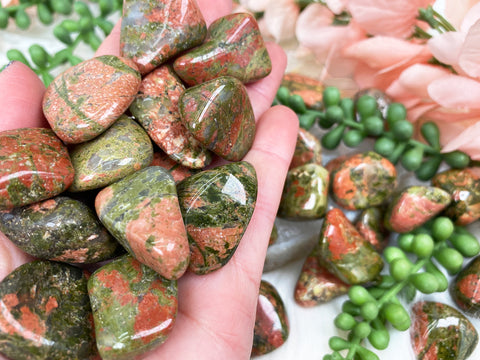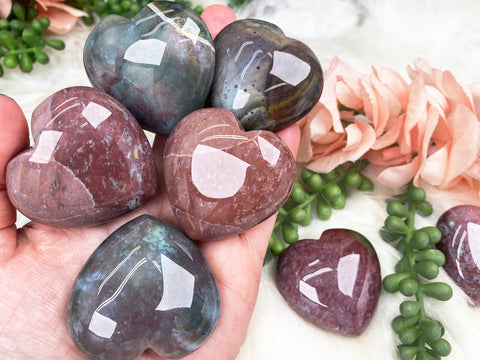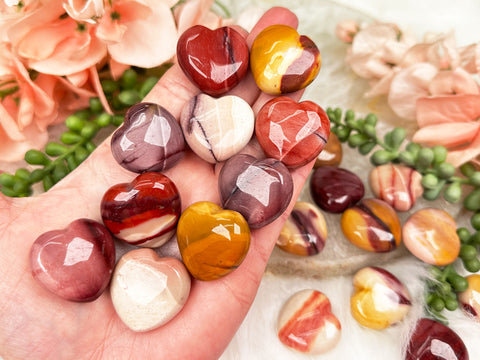Jasper stone is a diverse and opaque variety of chalcedony, often revered for its earthy colors and unique patterns. With a myriad of varieties such as Red Jasper, Picture Jasper, and Ocean Jasper, this versatile gemstone is known for promoting grounding energy, nurturing strength, and fostering a sense of stability and tranquility in its wearers. Learn more about the jasper meaning below.
-
Ibis Jasper Slices
Regular price $35.00Regular priceUnit price per -
Kambaba Jasper Hearts
Regular price $14 - $18Regular priceUnit price per$22.00Sale price $14 - $18 Sale -
Pink Petrified Wood Points
Regular price $26 - $31Regular priceUnit price per$30 - $36Sale price $26 - $31 Sale
Jasper Crystal
Let's take a look at the vast world of jasper stones! This is one of the most diverse of the crystal world, and throughout this post you will also see links to specific jasper crystals where you can learn even more about them.
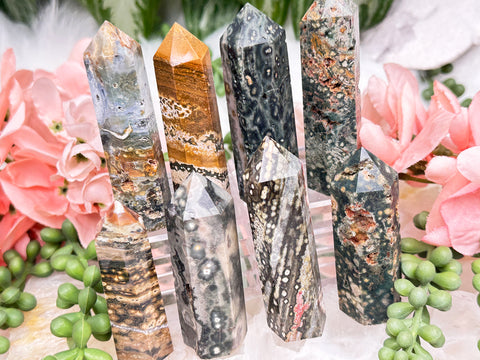
What Is Jasper?
Jasper, a fascinating variety of chalcedony, captivates with its rich array of colors and distinctive patterns. Formed through intricate geological processes, jasper is composed primarily of silicon dioxide, the same mineral that constitutes quartz. This gemstone is recognized for its opacity, distinguishing it from translucent chalcedony varieties.
The formation of jasper is a testament to the Earth's dynamic geological history. It originates in sedimentary environments where silica-rich materials, often derived from volcanic ash or organic debris, undergo a transformative journey. Over extended periods, mineral-rich water percolates through these materials, depositing silica and other trace minerals into the interstitial spaces. The subsequent processes of crystallization and compaction contribute to the solidification of these deposits, culminating in the creation of jasper.
In terms of hardness, jasper ranks between 6.5 and 7 on the Mohs scale. This places it in the category of semi-precious gemstones, making it durable and suitable for a range of applications, including jewelry, carvings, and ornamental items. The resilience of jasper, combined with its captivating appearance, has contributed to its enduring popularity throughout history. Whether as a polished cabochon, a raw specimen, or an intricately carved artifact, jasper continues to be cherished for its natural beauty and geological intrigue.
Where is Jasper Found?
Jasper occurs worldwide, and notable deposits can be found in diverse locations such as India, Russia, Brazil, Egypt, Madagascar, Australia, and the United States.
What Color Is Jasper?
Jasper exhibits a remarkable spectrum of colors, including red, brown, yellow, green, and occasionally blue. These hues are often attributed to the presence of various impurities, minerals, and organic material incorporated during the gemstone's formation. The distinctive patterns seen in jasper, such as swirls, spots, and stripes, further add to its aesthetic allure.
The Unique Formation Process of Jasper
Jasper, a microcrystalline variety of quartz, forms through a fascinating geological process that takes millions of years. It originates from silica-rich volcanic rock, where impurities such as iron oxides, clay minerals, and organic materials give each type of jasper its distinct color and patterns.
- Silica Deposits: Over time, groundwater rich in dissolved silica seeps into rock fractures and cavities, depositing layers of microcrystalline quartz.
- Color Variations: The incorporation of different minerals results in the wide variety of colors of jasper, ranging from deep reds and greens to intricate patterns found in Leopard Skin Jasper and Orbicular Jasper.
- Banded Patterns: Some jasper varieties, such as Banded Jasper, form due to rhythmic sedimentary deposits that create beautiful, layered appearances.
Types Of Jasper
Jasper exhibits a diverse range of types, each distinguished by its unique colors, patterns, and geological characteristics. Here are some notable types of jasper. Some you will find links to full write ups on them, and some you will find more detailed info below the list.

-
Red Jasper: Known for its deep red to terracotta hues, Red Jasper is associated with strength, vitality, and grounding energy. Learn more about Red Jasper >
-
Brecciated Jasper: This type features fragmented patterns and is composed of angular fragments naturally cemented together. It often displays a combination of reds, browns, and grays. It is sometimes known as Ibis Jasper.
-
Picture Jasper: Characterized by scenic or landscape-like patterns, Picture Jasper often resembles a painted picture. It can include earthy tones and scenic depictions.
-
Ocean Jasper: Recognized for its vibrant orbs and intricate patterns, Ocean Jasper often showcases a range of colors, including green, pink, and white, resembling oceanic landscapes. Learn more about Ocean Jasper >
-
Dalmatian Jasper: Notable for its spots reminiscent of the famous dog breed, Dalmatian Jasper is primarily beige or light brown with black or brown spots. Learn more about Dalmatian Jasper >
-
Mookaite Jasper: Originating from Australia, Mookaite Jasper displays a mix of earthy colors, including red, yellow, and brown, often in intricate patterns.
-
Fancy Jasper: Also known as Multi-Color Jasper, this type combines various colors, creating a harmonious blend of earthy tones.
-
Yellow Jasper: Characterized by its warm yellow tones, Yellow Jasper is associated with positivity, energy, and mental clarity.
-
Green Jasper: This type of jasper exhibits varying shades of green and is often associated with growth, healing, and connection to nature.
-
Poppy Jasper: Featuring a vibrant red color with black or dark brown patterns, Poppy Jasper is reminiscent of poppy flowers. It is associated with vitality, courage, and a positive outlook.
-
Rainforest Jasper: Also known as Rhyolite Jasper, this type showcases a mix of earthy greens, browns, and grays. Its intricate patterns evoke images of lush rainforest landscapes.
-
Zebra Jasper: Recognized for its black and white striped patterns, Zebra Jasper resembles the distinctive markings of a zebra. It is often used for grounding and balance. Learn more about Zebra Jasper >
-
Kambaba Jasper: Originating from Africa, Kambaba Jasper displays dark green to black orb-like patterns on a green background. It is associated with soothing energies and ancient Earth wisdom. Learn more about the Kambaba Jasper meaning >

-
African Queen Jasper: Characterized by its rich, warm tones of red, orange, and brown, African Queen Jasper exudes a regal and vibrant energy. It is often used for strength and endurance.
-
Silver Leaf Jasper: This type features silvery-gray patterns against a background of various earthy colors. It is valued for its calming and protective properties.
-
Cobra Jasper: With patterns resembling the skin of a cobra, this jasper type often displays intricate swirls and spots. It is associated with transformation and protection.
-
Desert Jasper: Found in sandy hues of beige, brown, and cream, Desert Jasper reflects the colors of desert landscapes. It is often used for grounding and connecting with the earth. But it can also come in a wide range of colors including teal, pink, red, blue and more, and has since come to also be known (sometimes more commonly) as polychrome jasper. Learn more about Polychrome Jasper >
-
Porcelain Jasper: Displaying patterns resembling fine china or porcelain, this jasper is known for its elegance and is often used for its calming and balancing energies.
-
Golden Jasper: Exhibiting warm golden tones, this type of jasper is associated with abundance, success, and positive energy.
- Unakite Jasper: Unakite is a distinct jasper variety known for its mottled green and pink hues, often resembling a landscape painted with soft brushstrokes. Composed of green epidote, pink orthoclase feldspar, and quartz, Unakite Jasper is valued for its harmonizing and balancing qualities. It is associated with emotional healing, compassion, and personal growth.
Now that you have a quick overview of each, let's dive into some of the more popular types of jasper a bit more. And just a reminder, ones like Ocean Jasper, Red Jasper and a handful more are linked above and have their own detailed pages.
Unakite Jasper
Unakite Jasper, a distinctive and aesthetically appealing gemstone, has its origins traced to the United States, specifically the Unakas Mountains in North Carolina. This jasper variety showcases a captivating combination of mossy green epidote and rosy pink orthoclase feldspar, often interspersed with milky quartz veins. Unakite's Mohs hardness typically ranges between 6 to 7, indicating a moderate level of durability suitable for various jewelry and ornamental applications.
The formation of Unakite is a result of metamorphic processes involving the alteration of granite rocks. Over time, as tectonic forces and heat transform the original minerals, the distinctive green and pink hues emerge. The intricate patterns and color variations within Unakite contribute to its unique and visually striking appearance, making it a popular choice among lapidaries and jewelry artisans.

Unakite Jasper Meaning
Beyond its aesthetic charm, Unakite Jasper is celebrated for its metaphysical properties. It is believed to have a soothing influence on emotions, promoting emotional healing and balance. Unakite is also associated with fostering compassion, empathy, and patience, making it a valuable tool for individuals seeking personal growth and harmonious relationships. Additionally, this gemstone is thought to aid in overcoming obstacles and facilitating a sense of calm during challenging situations.
In summary, Unakite Jasper stands out as a gemstone with a rich geological history, captivating visual appeal, and purported healing properties that extend beyond its ornamental use. Its unique composition and metaphysical attributes make it a cherished addition to both the world of gemstone enthusiasts and those seeking holistic well-being.

Green Jasper
Green Jasper, a captivating member of the jasper family, derives its unique qualities from various geological and mineralogical factors. While green jasper can be found in multiple locations worldwide, notable deposits exist in India, Russia, Brazil, and the United States.
Green Jasper's appearance is characterized by a spectrum of green tones, ranging from earthy olive and forest green to deeper emerald shades. The presence of minerals like chlorite, amphibole, or other green-hued compounds contributes to its distinctive coloration. With a Mohs hardness ranging from 6.5 to 7, green jasper is sufficiently durable for use in jewelry, carvings, and decorative items.
This jasper variety is formed through sedimentary processes where silica-rich materials solidify over time. The incorporation of various minerals during this process, coupled with geological pressures, results in the vibrant green hues and unique patterns seen in green jasper specimens.
Green Jasper Meaning
Beyond its geological origin, green jasper is associated with metaphysical properties. It is believed to enhance one's connection to nature, promote balance and stability, and instill a sense of tranquility. Green jasper is also thought to support personal growth and strengthen the connection between the physical and spiritual aspects of an individual.
In summary, green jasper stands as a testament to the Earth's geological diversity, offering a harmonious blend of visual appeal and purported metaphysical benefits. Its lush green tones and symbolic connections make it a sought-after gemstone for those seeking both aesthetic beauty and holistic well-being.
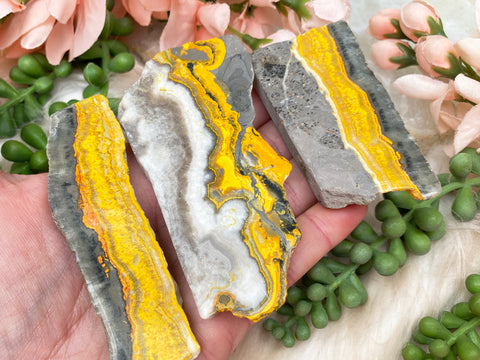
Bumblebee Jasper
Bumblebee Jasper, a distinctive and visually striking gemstone, is renowned for its vibrant colors and unique patterns. Despite its name, it is not a true jasper; instead, it is a combination of volcanic matter, sediment, and anhydrite. This gemstone is primarily sourced from the volcanic regions of Indonesia, particularly Java.
The characteristic colors of Bumblebee Jasper range from bright yellows and oranges to deep blacks, often resembling the vibrant hues of a bumblebee, hence its name. The vivid colors are attributed to the presence of sulfur, arsenic, and other minerals within the stone.
Formed in hydrothermal vents, Bumblebee Jasper undergoes a complex geological process. Hot, acidic fluids carrying various minerals, including sulfur, permeate the rocks. As these fluids cool and solidify, the unique patterns and color variations emerge, creating the distinctive appearance that sets Bumblebee Jasper apart.
With a hardness ranging from 5 to 6 on the Mohs scale, Bumblebee Jasper is relatively soft compared to other gemstones. Despite this, it is still utilized in jewelry, carvings, and ornamental items. However, care must be taken to avoid exposure to harsh chemicals or excessive heat, which can potentially damage the stone.
Bumblebee Jasper Meaning
Metaphysically, Bumblebee Jasper is esteemed for its diverse healing properties, particularly in connection with the solar plexus chakra. This gemstone is believed to infuse its possessor with a vibrant energy that revitalizes the spirit, fostering a sense of joy, positivity, and enhanced vitality. Its dynamic blend of yellows and oranges is thought to dispel lethargy and negativity, offering a renewed enthusiasm for life.
Aligned with the solar plexus chakra, Bumblebee Jasper is associated with promoting confidence and self-expression. Wearers may find that it empowers them to embrace authenticity, speak their truth, and navigate social situations with assurance. Beyond its grounding and energizing effects, this gemstone is seen as a source of creative inspiration, stimulating the imagination and aiding in spiritual alignment for those seeking a deeper connection with their higher selves and spiritual insights.
In summary, Bumblebee Jasper's distinctive appearance, geological origin, and metaphysical attributes make it a captivating and sought-after gemstone for those who appreciate its unique blend of colors and energy.
Fancy Jasper
Fancy Jasper, also known as Multi-Colored Jasper or Rainbow Jasper, is a captivating and versatile gemstone valued for its diverse colors and unique patterns. This variety of jasper can be found in various locations worldwide, including India, Russia, Venezuela, and the United States. It is known for its rich and earthy hues, with colors ranging from greens and reds to browns and creams.
Composed primarily of microcrystalline quartz, Fancy Jasper is a type of chalcedony, often intermixed with other minerals. Its striking appearance results from the presence of impurities, minerals, and inclusions, which contribute to the diverse color palette seen in different specimens. With a Mohs hardness ranging from 6.5 to 7, Fancy Jasper is durable enough for use in a variety of jewelry and ornamental applications.
The formation of Fancy Jasper is a result of sedimentary processes over extended periods. Silica-rich materials, like mud and volcanic ash, solidify and undergo mineralization, giving rise to the intricate patterns and vibrant colors observed in Fancy Jasper. The blending of various minerals during this geological process creates the unique visual appeal that sets this jasper variety apart.
Fancy Jasper Meaning
Beyond its aesthetic charm, Fancy Jasper is renowned for its metaphysical properties. It is believed to have a grounding and stabilizing influence, fostering a sense of tranquility and balance. This gemstone is thought to encourage mental clarity, focus, and a connection with the natural world. Additionally, Fancy Jasper is associated with promoting a sense of wholeness and nurturing positive energies, making it a popular choice among individuals seeking both aesthetic beauty and holistic well-being.
In summary, Fancy Jasper stands as a testament to the Earth's geological diversity, offering a harmonious blend of visual appeal and purported metaphysical benefits. Its diverse colors, unique patterns, and symbolic connections make it a cherished gemstone for those who appreciate its multifaceted nature and potential healing attributes.
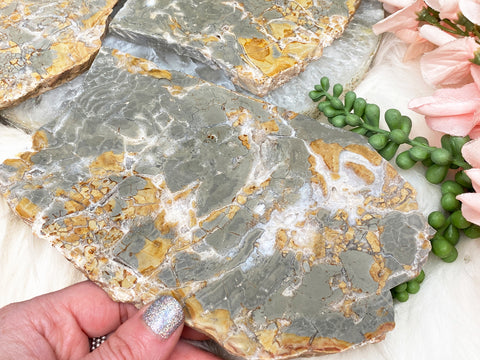
Brecciated Jasper
Brecciated Jasper, also known as Ibis Jasper, is a distinctive and captivating gemstone celebrated for its unique appearance and varied healing properties. This form of jasper can be sourced from different locations worldwide, including China, Brazil, and the United States. It is characterized by its mosaic-like patterns and a blend of rich earthy tones such as reds, browns, and creams.
Comprising primarily microcrystalline quartz, Brecciated Jasper is a type of chalcedony. Its visually striking appearance is attributed to the presence of fragmented mineral inclusions within the stone, creating a mosaic or breccia-like pattern. With a Mohs hardness ranging from 6.5 to 7, Brecciated Jasper is durable and suitable for various jewelry and decorative applications.
The formation of Brecciated Jasper is a result of geological processes involving the consolidation of fragmented rocks and minerals. Over time, the integration of these fragmented components, possibly due to tectonic activity or weathering, results in the distinctive patterns observed in Brecciated Jasper.
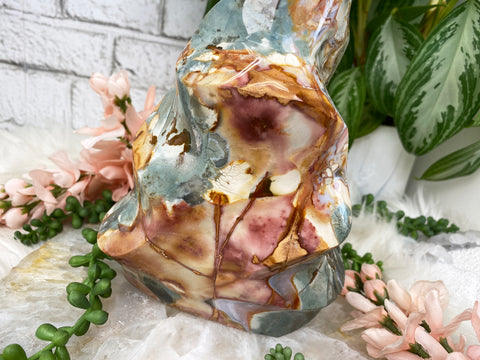
Brecciated Jasper Meaning
Metaphysically, Brecciated Jasper is revered for its grounding and nurturing properties. It is believed to enhance mental clarity, focus, and organizational skills. The stone's association with the root chakra contributes to its grounding effects, fostering a sense of stability and connection to the earth. Brecciated Jasper is also thought to instill a sense of vitality, promoting physical strength and endurance.
Additionally, this jasper variety is considered a protective stone, aiding in the release of stress and promoting a harmonious balance between the physical, emotional, and spiritual aspects of an individual. Some individuals turn to Brecciated Jasper for its potential to stimulate creativity and aid in overcoming obstacles.
In summary, Brecciated Jasper, or Ibis Jasper, stands as a testament to the Earth's geological artistry, offering a visually striking gemstone with both aesthetic and potential metaphysical benefits. Its unique patterns, earthy tones, and purported healing attributes make it a sought-after gemstone for those seeking a harmonious blend of beauty and well-being.
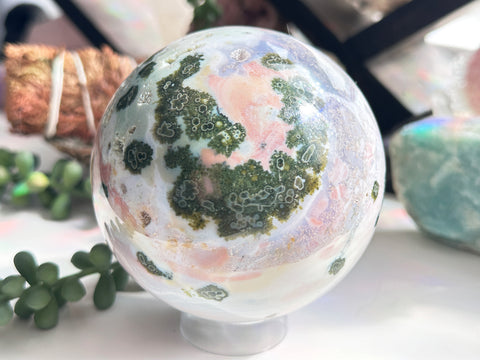
Picasso Jasper
Picasso Jasper, a distinctive and visually captivating gemstone, is renowned for its unique patterns and earthy color palette. This form of jasper, also known as Picasso Marble or Picasso Stone, is primarily found in Utah, USA, and is characterized by its intricate veining, splashes of color, and abstract designs reminiscent of Picasso's artwork.
Comprising microcrystalline quartz and other minerals, Picasso Jasper exhibits a diverse range of colors, including browns, grays, greens, and occasional splashes of red or yellow. Its appearance is often likened to a miniature landscape, with each stone resembling a one-of-a-kind piece of art. With a Mohs hardness ranging from 6.5 to 7, Picasso Jasper is durable and suitable for use in various jewelry and ornamental applications.
The formation of Picasso Jasper is a result of sedimentary processes over extended periods. Silica-rich mudstone undergoes mineralization, with various minerals, including hematite and goethite, contributing to the distinctive veining and patterns seen in Picasso Jasper. The stone's unique appearance is further enhanced by natural weathering processes, giving each specimen its individual character.
Picasso Jasper Meaning
Metaphysically, Picasso Jasper is associated with grounding and calming energies. It is believed to promote a sense of balance, harmony, and integration within the physical, emotional, and spiritual aspects of an individual. Picasso Jasper is often turned to for its potential to stimulate creativity and enhance artistic endeavors. Its abstract patterns are thought to encourage a flow of inspiration and imagination.
Additionally, Picasso Jasper is considered a protective stone, helping to dissipate negative energies and promote a sense of tranquility. It is often used in meditation practices to connect with the earth's energies and foster a deeper understanding of one's inner self.
In summary, Picasso Jasper stands as a unique gemstone, showcasing nature's artistry in every intricate detail. Its abstract patterns, earthy hues, and purported metaphysical properties make it a sought-after choice for individuals seeking both aesthetic beauty and holistic well-being.

Mookaite Jasper
Mookaite Jasper, a captivating gemstone named after the Mooka Creek in Western Australia where it was first discovered, is celebrated for its vibrant hues and diverse patterns. This form of jasper is primarily found in Australia and is characterized by a rich palette of colors, including mustard yellows, burgundy reds, earthy browns, and creamy whites.
Composed mainly of microcrystalline quartz, Mookaite Jasper exhibits intricate patterns and a range of colors due to the presence of iron oxide and other minerals. With a Mohs hardness ranging from 6.5 to 7, Mookaite is durable enough for use in various jewelry and ornamental applications.
The geological formation of Mookaite is attributed to the sedimentation of microscopic organisms in ancient seabeds. Over millions of years, the minerals in these sediments crystallized, resulting in the distinctive patterns and vibrant colors seen in Mookaite Jasper. The varied shades and patterns often resemble landscapes, creating unique and picturesque stones.
Mookaite Jasper Meaning
Metaphysically, Mookaite Jasper is revered for its grounding and nurturing properties. It is believed to promote feelings of stability, encouraging individuals to stay rooted in the present moment. Mookaite is also associated with the solar plexus, root, and third eye chakras, fostering a harmonious balance between physical strength, intuition, and emotional well-being.
This jasper variety is thought to enhance decision-making skills, provide protection during physical activities, and stimulate one's adventurous spirit. Mookaite is believed to aid in accepting change and adapting to new situations, making it a valuable ally during transitional phases in life.
In summary, Mookaite Jasper stands as a testament to the diverse beauty found in nature, showcasing an array of colors and patterns that evoke the landscapes of its Australian origins. Its earthy hues and metaphysical attributes make it a sought-after gemstone for those seeking a harmonious blend of aesthetic appeal and holistic well-being.

Yellow Jasper
Yellow Jasper, a radiant and warm-hued gemstone, is valued for its sunny coloration and positive metaphysical attributes. This form of jasper can be found in various locations worldwide, including Brazil, Madagascar, Russia, and the United States. It is characterized by its vibrant shades of yellow, ranging from pale buttery tones to deep golden hues.
Composed mainly of microcrystalline quartz, Yellow Jasper derives its distinctive color from the presence of iron and other mineral inclusions. With a Mohs hardness ranging from 6.5 to 7, Yellow Jasper is relatively durable, making it suitable for use in a variety of jewelry and ornamental applications.
Geologically, Yellow Jasper is formed through the gradual consolidation of sedimentary deposits and the subsequent mineralization of silica-rich materials. Over time, these processes create the unique patterns and vibrant colors observed in Yellow Jasper. The stone often features interesting veining, mottling, or banding that enhances its visual appeal.
Yellow Jasper Meaning
Metaphysically, Yellow Jasper is associated with positivity, protection, and balance. It is believed to instill a sense of optimism, helping to dispel negativity and encourage a sunny outlook on life. Yellow Jasper is often turned to for its potential to enhance one's endurance, courage, and determination, making it a supportive companion during challenging times.
Aligned with the solar plexus chakra, Yellow Jasper is thought to promote a harmonious balance between one's personal power, confidence, and inner strength. It is believed to foster a sense of stability and encourage individuals to pursue their goals with a clear and focused mindset.
In summary, Yellow Jasper stands as a symbol of sunshine and positivity within the world of gemstones. Its vibrant color, geological origins, and metaphysical associations make it a cherished choice for those seeking both aesthetic beauty and uplifting energies in their gemstone collections.

Picture Jasper
Picture Jasper, a captivating and unique form of jasper, is celebrated for its scenic and picturesque patterns that resemble landscapes, scenes, or abstract art. This variety of jasper is found in various locations globally, including the United States, Madagascar, and Venezuela. It is characterized by its earthy tones, intricate designs, and the illusion of captured natural scenes within the stone.
Comprising microcrystalline quartz, Picture Jasper obtains its distinctive appearance from the presence of mineral and organic inclusions. With a Mohs hardness ranging from 6.5 to 7, Picture Jasper is durable and suitable for use in various jewelry and decorative applications.
The geological formation of Picture Jasper involves the consolidation of fine-grained materials, such as clay or mud, rich in silica. Over time, these materials undergo mineralization, resulting in the unique and picturesque patterns observed in Picture Jasper. The stone often showcases a harmonious blend of colors, including shades of brown, tan, cream, and sometimes hints of red or green.
Picture Jasper Meaning
Metaphysically, Picture Jasper is associated with grounding and connection to the earth. It is believed to have a calming and nurturing effect, promoting a sense of stability and balance. The unique patterns within the stone are thought to stimulate creative visualization, making it a favored choice for those seeking inspiration or wanting to enhance their artistic endeavors.
Aligned with the root chakra, Picture Jasper is believed to enhance feelings of security, courage, and a deeper connection to the natural world. It is often turned to for its potential to bring about a sense of wholeness and understanding, encouraging individuals to appreciate the beauty in both their internal and external landscapes.
In summary, Picture Jasper stands as a canvas of nature's artistry, offering a visual journey within the stone. Its scenic patterns, earthy hues, and metaphysical attributes make it a sought-after gemstone for those seeking both aesthetic beauty and a connection to the grounding energies of the earth.
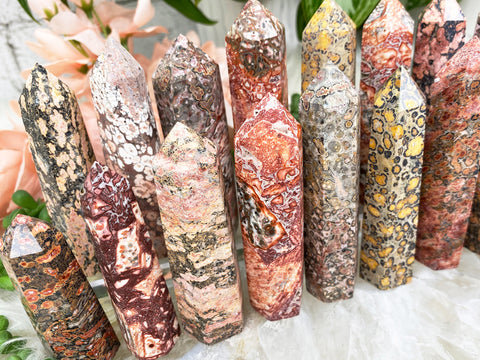
Metaphysical Properties and Healing Benefits of Jasper
Jasper has been valued for its grounding and protective energy for centuries. Many believe it fosters emotional stability, creativity, and endurance.
- Emotional Healing: Jasper is associated with calming anxiety and providing a sense of security.
- Chakra Alignment: Different jasper varieties resonate with different chakras:
- Red Jasper – Root chakra (stability, grounding)
- Yellow Jasper – Solar plexus chakra (confidence, energy)
- Green Jasper – Heart chakra (emotional balance, healing)
- Spiritual Protection: Leopard Skin Jasper and Orbicular Jasper are often used to ward off negative energies.
How to Care for and Clean Jasper
To maintain the beauty and energy of your jasper jewelry and stones, follow these care tips:
- Avoid Harsh Chemicals: Do not expose jasper to acidic cleaners or prolonged sunlight, as this can fade its vibrant colors.
- Clean Jasper Gently: Use warm soapy water and a soft cloth; avoid ultrasonic cleaners, especially for dyed jaspers.
- Recharge in Nature: Place your jasper stones under the moonlight or bury them in the earth to cleanse and recharge their energy.

Frequently Asked Questions About Jasper
1. What is the difference between Jasper and Agate?
Jasper is opaque and forms through sedimentary processes, while agate is translucent with banded formations, typically found in volcanic rock.
2. Can Jasper be used in water?
Jasper is generally safe in water, but prolonged exposure may weaken its structure, especially for porous varieties.
3. Is Leopard Skin Jasper a real jasper?
Leopard Skin Jasper is technically a rhyolite, not a true jasper, but it shares similar properties and is classified as jasper in the gem trade.
4. What is Orbicular Jasper?
Orbicular Jasper is a rare variety of jasper that features circular or orb-like formations, often in Ocean Jasper and Leopard Skin Jasper.
5. Where is the best quality Jasper found?
Some of the most sought-after jaspers come from Australia (Noreena Jasper), Madagascar (Ocean Jasper), the United States (Picture Jasper, Biggs Jasper), and Russia (Orbicular Jasper).
6. How do you identify real Jasper?
Real jasper has an opaque appearance, smooth texture, and intricate natural patterns. It should feel solid and dense when held.
7. Can Jasper be dyed?
Yes, some jasper varieties, like Dyed Jasper, are artificially colored to enhance their visual appeal. These should be kept away from harsh chemicals to prevent fading.
8. What is the spiritual meaning of Jasper?
Jasper is often called the “Supreme Nurturer” because it provides stability, emotional resilience, and grounding energy.






